|
In the immediate post-Mega Man 9 world, "innovation" was not exactly the first thing one would associate with Capcom. Yet somehow, through some bureaucratic miracle, the Ace Attorney team was given the chance to do something different. The fifth Ace Attorney game (perhaps, as the two-part title indicates, the start of a new, infinitely reiterating franchise of its own) introduces a whole set of new gameplay elements. None of these elements address the series’ weaknesses (namely the lack of replayability) but are polished enough not to introduce many of their own. As a result, it’s hard to tell how much the series will return to The Old Ways when it means tossing aside a well oiled set of new, clever ideas.
As you can guess from the title, the game stars Edgeworth rather than Phoenix or Apollo, with a rotating stable of assistants to take the place of Maya or Trucy. The transition is not perfect, as the writers cannot seem to get around the idea of defending some poor innocent at every turn, even though you’re in control of a prosecutor and the incentive should no longer be required, but it’s only a minor hiccup.
The story jumps in between the third and forth game chronologically, joining up with Edgeworth seemingly just after he returns from a trip to study abroad after the closing of Trials and Tribulations. As it turns out, the game is being told out of chronological order, telling the story of a global smuggling ring and the vigilante corporate spy known as "The Yatagarasu".
Case 1 - Turnabout Visitor
Edgeworth returns to his office after more than 24 hours awake only to be held at gunpoint in the dark by a stranger claiming to be the long-forgotten Yatagarasu, a super-thief that used to steal malicious corporate data and release it to public. They exchange threats before the thief puts a bullet into Edgeworth’s wall and bolts, leaving him behind with the corpse of a cop slumped against his bookcase.
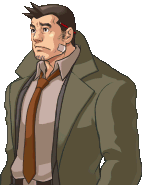 |
Dick Gumshoe / Keisuke Itonokogiri
Everyone’s favourite scruffy detective returns to the series with the demeanour and impotence of a wide-eyed puppy series fans have come to love. Gumshoe is Edgeworth’s most prominent "Assistant" character, following him around and providing his own brand of insight for close to half the game. Considering that we saw him no more than an in-game month ago in T&T, he hasn’t changed much.
|
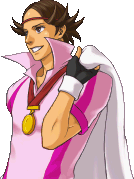 |
Jacques Sportsman / Makoto Yuuki
Edgeworth’s new neighbour in the building. The dead cop in Edgeworth’s office was his partner and he’s apparently quite distraught - at least, distraught enough to start pointing fingers at all and sundry, forcing Edgeworth to shoot down each new accusation one tutorial after another.
|
Case 2 - Turnabout Airlines
Winding back the clock to the beginning of Edgeworth’s very long day, we tune in to his trans-Atlantic flight home to find him tied to his first-class chair under a citizen’s arrest, having been found at the scene of a murder in the in-flight lounge. After convincing the flight crew of his innocence, Edgeworth discovers the victim was secretly an Interpol agent whose investigations into an international smuggling ring may or may not have led to his demise.
 |
Rhoda Teneiro / Ichiru Konomichi
The flight attendant who arrests Edgeworth and later serves as his assistant. Rhoda is extremely by-the-book in her behaviour but cuts loose by indulging her putrid sense of design. Her role as arresting officer and then assistant comes full circle when she’s finally held for questioning as the police department’s prime suspect.
|
 |
Cammy Meele / Wakana Shiraoto
The other flight attendant in first-class is barely there, in the sense that she spends half of her conversations falling in and out of a narcoleptic stupor. Her flirtatious relationship with the captain (not to mention her gratuitous cleavage) let her stay more or less off of her actual shift, so her role in the plot doesn’t really pick up until the investigation pushes into the flight attendant’s bedrooms where she spends most of her time asleep.
|
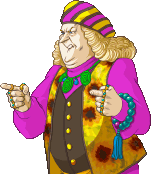 |
Zinc Lablanc II / Zinc White II
A Borginian artefact collector also travelling in first class. He speaks in broken English and is only concerned with his timetable and his shipment of luxuries kept sealed up in the cargo bay. Apparently he’s never heard of dedicated air freight. His pun name is a reference to the use of zinc in white paints.
|
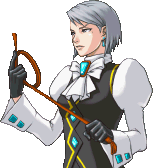 |
Franziska von Karma / Mei Karuma
Edgeworth’s whip-happy "little sister" is back and not at all pleased by his being arrested at the scene. Having been drafted as an Interpol lawyer set to meet with the victim, she is put in charge of the prosecution on the case and serves primarily as your opponent. She will throughout the rest of the game as well, usually serving as your assistant (or vice versa).
|
Case 3 - The Kidnapped Tournabout
Edgeworth isn’t long on the ground after his flight when he’s called by the benefactor of his worldwide tour with bad news: the man’s son has been kidnapped. Paying the ransom in person at an old haunted house attraction, Edgeworth is set upon by a pupil-less theme park mascot in one of the downright creepiest scenes in gaming and wakes up trapped in a employee changing room.
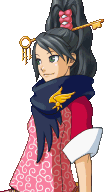 |
Kay Faraday / Mikumo Ichijou
Having been cut from Case 2 (she can be seen there in the trailer), Kay makes her first appearance in this case by rescuing Edgeworth from his starting predicament. Athletic and spry, Kay claims quite enthusiastically and to anyone that can hear her (no matter how associated they may be with the legal system) that she is the successor of the Great Thief Yatagarasu. While her personality is more or less down the same rut as Maya and Trucy, she is more keen to follow along with the protagonist's thought process and even draws conclusions of her own from time to time, which is nice. Despite her appearance on the cover, her cut from Case 2 means that she only really appears in two cases, along with a supporting role in Case 4.
|
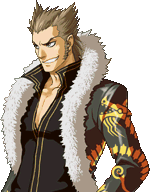 |
Shi-Long Lang / Shiryuu Rou
With their original agent dead before he even reached the country, Interpol sent "The Wolf" in his place. Despite supposedly being knee-deep in investigating the smuggling ring, Lang insists that he be allowed to run the theme park kidnapping and quickly seizes control with the help of his "pack" of ultra-obedient officers. Lang is from the newly made-up East Asian country of Zheng Fa and is a descendant of a great lawmaker, whom he quotes constantly from an elaborate scroll. Lang is quick to pull out his handcuffs and serves as your opponent both here and in Case 5.
|
 |
Shih-na / Shiina
Lang’s silent companion, Shih-na is also an agent of Interpol and, like the rest of his pack, holds his full trust and, by extension, all of his power. She takes a more active role in case 5 when she and Lang are forced to operate apart from one another.
|
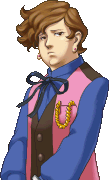 |
Lance Amano / Hikaru Amanogawa
The kidnapping victim and spoiled son of Edgeworth’s benefactor, Ernest Amano (Jouichirou Amanogawa), who also appears. Lance eventually shows up after a few plot twists, his disoriented testimony being all you have to work with to catch his captors.
|
 |
Lauren Paups / Himeko Orito
"Lolly" Paups, the Amano’s maid and Lance’s secret girlfriend, shows up on the scene not long after the start of the case, constantly licking the Ring Pop on her finger and bewailing the fate of her beloved. She falls in love with Edgeworth at first sight, as she seems to do with more or less anyone.
|
Case 4 - Turnabout Reminiscence
The fourth case is set far in the past, the furthest back the series has gone (thanks to the gap between release dates, this is almost set on the present day). While two unfamiliar lawyers try a murder case critically related to the investigation of the original Yatagarasu, the court is stopped dead when the defendant accuses the prosecutor of being the thief himself. A replacement prosecutor has to be called for and Edgeworth is brought in for his first case, but before it can begin both defendant and the original prosecutor are found dead in a classic "locked room" scenario. One of the victims, Bryne Faraday, was the prosecutor in charge of years of Yatagarasu investigations and, by extension, the corporate crime the Great Thief unmasked. He is also Kay’s father, which opens up new mysteries such as why she would grow up to take on the mantle of the one who essentially led to her father’s death.
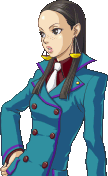 |
Calisto Yew / Himiko Kazura
A defence attorney, Calisto is also more involved in the case than it first seems, as her sister was killed in the same location and in a similar manner to the murder on trial. Despite the sombreness of the situation, Calisto just can’t help breaking down into fits of laughter. This gets annoying before the case is over, but her reactions to Edgeworth’s pretentious speech and the series’ clichés is worth the figurative price of admission.
|
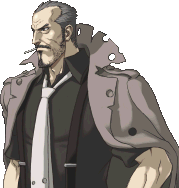 |
Tyrell Badd / Ittetsu Badou
Detective Gumshoe’s superior, Detective Badd is faded as a ghost and wears a worn coat full of bullet holes, both from years on the force. Faraday’s partner, he was the investigator on the Yatagarasu cases and now has the unenviable job of processing his friend’s murder. Given the circumstances, it’s not surprising that he’s hesitant to work with the extra-green Edgeworth (and the preteen Franziska) and, as such, his years of experience will prove hard to tap.
|
Case 5 - Turnabout Ablaze
The embassy of a country called Cohdopia, scene of both the Yew murder and the murder on trial in Case 4, is the scene of the final case as it plays host to a series of reoccurring characters, but for Edgeworth and Kay, the real show is the series of crimes that hit it in the middle of the night. The country it represents having been fractured by civil war, the embassy too is now split between both sides, forcing a legal tangle when these crimes erupt in both countries. Kay is convinced the Yatagarasu has struck, while Franziska, Lang and Shih-na are hot on the trail of the smuggling ring. With the plots turning out to be just as tangled as you probably imagine, this case results in not one but two major villain take-downs.
 |
Ambassador Colias Palaeno / Damian Hinje
The helpful Ambassador of the country of Babahl, Palaeno is more than willing to let you ransack his arson-ravaged office for clues. He appears to be completely helpless without his secretary, the murdered victim of another of almost half a dozen crimes committed during the night. Ambassador Palaeno is constantly peddling off coupons in hopes of attracting tourists to his Eastern European republic and is unendingly polite.
|
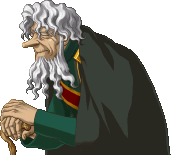 |
Ambassador Quercus Alba / Carnage Onred
A former Cohdopian general, Ambassador Alba of the Kingdom of Allebahst is now hunched over, feeble and in love with the Steel Samurai television program. Like Palaeno, he is unendingly polite, if heavier fisted thanks to his connection with his tighter-governed country. As his names imply (references to a tree and a carnation, respectively), his hobbies revolve around plants. The Allebahstians have sided with Interpol in this investigation, meaning that nearly every attempt to step on their soil is precluded by a logical debate with Franzika or Lang.
|
With Kay definitely by your side during the evening's activities, it’s clear that there are two persons walking about with the mantle of the Great Thief. What happens to be drawing break-ins to the Codohpian embassy even after all these years remain to be seen, but with the game at its end you can be sure it won’t come to a close before the hood is yanked off of this modern-day Robin Hood.
With the Ace Attorney series known in Japan as Gyakuten Saiban (Tournabout Courtroom), this fifth game was announced under the teaser title "Gyakuten NOT Saiban," implying that the courtroom sequences would be cut. This is both true and, mechanically, not true. True: the game is entirely based on the investigation portions of the previous games expanded a hundredfold. On the other hand: the courtroom sequences were essentially just one long dialogue intermixed with cross-examinations using 3rd person view instead of first. So, while this game has no true "courtroom scenes," it does include extended dialogues intermixed with cross-examinations done in third person, and even has one sequence in an actual court during Case 4, blurring the line. These sections are not the game’s strongest points (the cross-examination that ends the game is torturously long), which shows both the strength of the new additions but also the strength of justifying the cross-examinations with their original court setting.
Investigations, rather than being done in point-and-click style like in the other games, are done instead by moving your character around an environment (either with the D-Pad or stylus) and interacting with it, sometimes entering a point-and-click close-up. Capcom clearly had either a skilled team of animators or at least someone with a good deal of time on their hands, as the third person sprites are entirely new, comprehensive and even feature animations for characters that barely needed to be moving around at all (such as the victim of Case 1, who appears, walking, for about a full second in Case 3), which speaks volumes about the amount of care put into the product. Close-up sprites, used in dialogues, are almost entirely new; even some of Edgeworth and Franziska’s court sprites from previous games are redrawn. The game rejects the previous DS entries’ "all 3D" approach to the court record, but most key pieces of evidence are still available for close, 3D examination.
As the player investigates, they will collect evidence as before but also more abstract ideas and concepts sorted into Logic Mode. The advertisements for the game billed this part of the game as key, but you find soon after the second case that this feature may have taken a hit somewhere between the design doc and the release. It works as follows: the player can take the pieces of Logic and combine them to draw a conclusion that will unlock areas, evidence or more Logic. To make up an example, you could combine the evidence of curved glass shards with one of large-print books to conclude that the owner must have vision problems and may be far-sighted.
While this is a brilliant approach to mystery gameplay and is fun while it lasts, the game is not as ambitious with it as it tends to be with everything else. The elementary conclusions you draw in the tutorial are barely less complicated than those at the end of the game, even as cross-examinations reach the series’ usual heights of complexity. Worse, evidence cannot truly be combined in Logic mode. Some pieces of evidence do appear, but they are simply filed alongside concepts into your logic file. There, they are unusable for any other purpose until you have formed the logical connection that puts them into your court record proper. Despite its faults, the idea of Logic Mode seems to have been hijacked by Atlus for the upcoming Trauma Centre game’s Diagnostics and Forensics modes, where combining ideas will form the body of gameplay rather than the side.
Logic mode is not the only kind of puzzle you’ll encounter. As mentioned above, cross-examinations return outside of the courtroom more or less unmolested. The player can also point out contradictions in the environment, which is such a simple but brilliant development that it is almost certain to return even in the main series. There are also a few sections in the third and final case where Kay will bring out one of her thieving tools: a complete holographic projector that can create digital scenes. You use these to extrapolate on the facts you already have and find any contradictions that might arise from them. These few short sequences are some of the best parts in the game and work brilliantly with Logic Mode. Perhaps the designers decided it was a touch too powerful, considering it only makes a few brief and only one extended appearance.
It’s worth noting that this game was not originally developed for Edgeworth but rather for Detective Ema Skye, and thus would have been set during the second generation. The remnant of this is present if you know where to look, although it’s hard to tell if the changes are truly "losses." Given Ema’s predilection for scientific investigation, one could have expected another slew of forensic mini-games, but none are present (incidentally, this loss means that no part of the game actually requires the touch screen if you choose not to use it). Rather, when the power of the CSIs is required, Edgeworth will call on one the ever-present officers to have certain evidence processed, but only if the situation expressly demands it. Why forensics were taken out of your hands (either to hurry the game to completion, because of complaints lodged against the mini-games in previous games or to simply keep the player from discovering clues ahead of time) is unclear, but the use of secondary characters is not exactly jarring and at least differentiates between Edgeworth’s professional organization and Phoenix’s lucky bumbling.
This game marked the return of Noriyuki Iwadare to composing (his first in-game Ace Attorney work since the third game’s GBA release, although he was involved with some of the orchestral productions made of the games’ soundtrack), along with Yasuko Yamada of Bubble Symphony. The new soundtrack features a subtler Objection and Cornered themes but makes more prominent use of the Confess the Truth theme seeing as how the other two are mostly confined to cross-examination sections.
All around, the fifth game was a financial success (pulling in just under the runaway success of Kingdom Hearts DS). Given that it is a Capcom game, a direct sequel is probable, but whether the very next game in the universe will star Apollo, Edgeworth or jump to a new character has yet to be seen. Which gameplay elements, if any, will be cannibalized when the series does return to Mr. Justice is up in the air as well. Fans will have to wait and see, as series creator Shu Takumi has been sidetracked creating the new game Ghost Trick, to be launched later in 2010.
|
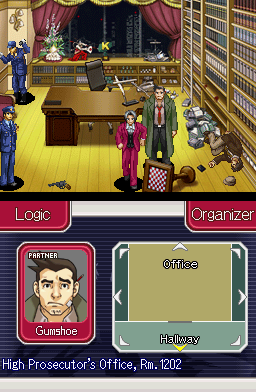
Ace Attorney Investigations: Miles Edgeworth
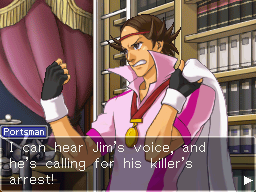
Ace Attorney Investigations: Miles Edgeworth
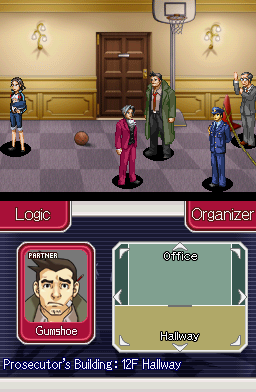
Ace Attorney Investigations: Miles Edgeworth
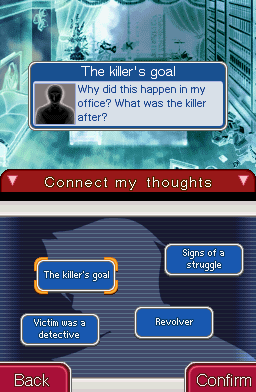
Ace Attorney Investigations: Miles Edgeworth
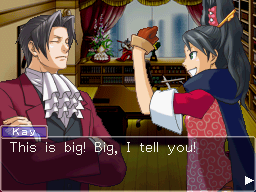
Ace Attorney Investigations: Miles Edgeworth
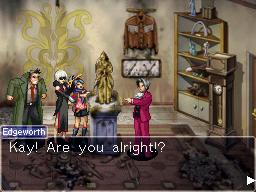
Ace Attorney Investigations: Miles Edgeworth
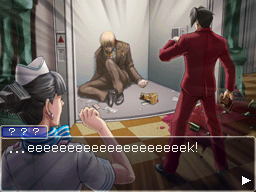
Ace Attorney Investigations: Miles Edgeworth
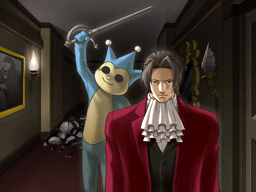
Ace Attorney Investigations: Miles Edgeworth
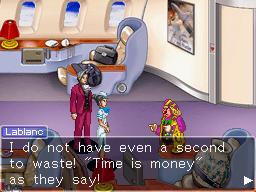
Ace Attorney Investigations: Miles Edgeworth
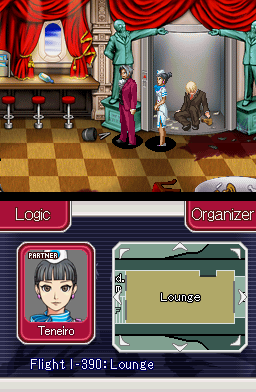
Ace Attorney Investigations: Miles Edgeworth
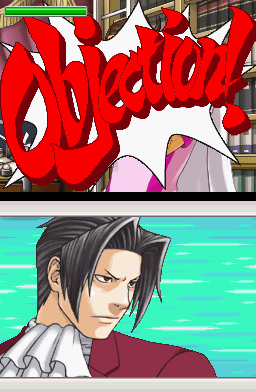
Ace Attorney Investigations: Miles Edgeworth
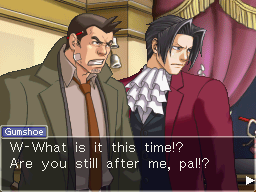
Ace Attorney Investigations: Miles Edgeworth
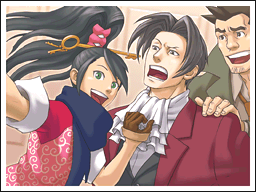
Ace Attorney Investigations: Miles Edgeworth
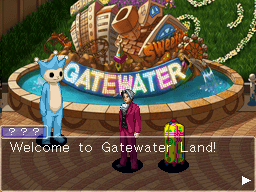
Ace Attorney Investigations: Miles Edgeworth
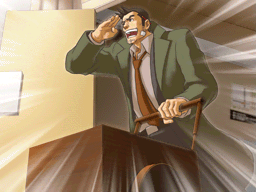
Ace Attorney Investigations: Miles Edgeworth
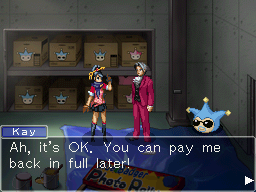
Ace Attorney Investigations: Miles Edgeworth
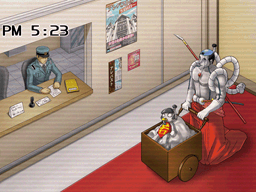
Ace Attorney Investigations: Miles Edgeworth
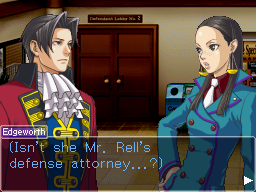
Ace Attorney Investigations: Miles Edgeworth
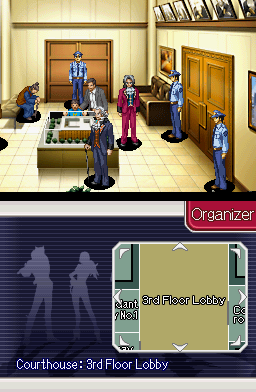
Ace Attorney Investigations: Miles Edgeworth
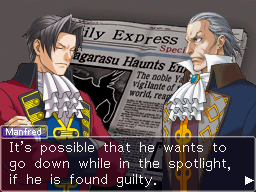
Ace Attorney Investigations: Miles Edgeworth
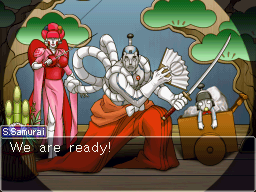
Ace Attorney Investigations: Miles Edgeworth
|


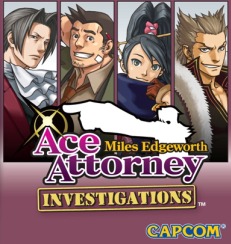
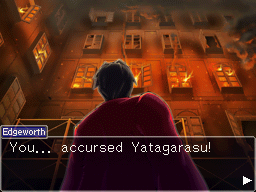
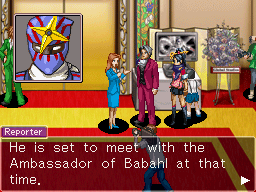
![]()
![]()
![]()
![]()
![]()
![]()
![]()
![]()
![]()
![]()
![]()
![]()
![]()
![]()
![]()





















